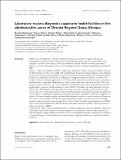| dc.contributor.author | Hailegiorgil, Bereket | |
| dc.contributor.author | Girma, Samuel | |
| dc.contributor.author | Melaku, Zenebe | |
| dc.contributor.author | Teshi, Takele | |
| dc.contributor.author | Demeke, Leykun | |
| dc.contributor.author | Gebresellasie, Sintayehu | |
| dc.contributor.author | Yadeta, Damtew | |
| dc.contributor.author | Tibesso, Gudeta | |
| dc.contributor.author | Whitehurst, Nicole | |
| dc.contributor.author | Yamo, Emanuel | |
| dc.contributor.author | Carter, Jane | |
| dc.contributor.author | Reithinger, Richard | |
| dc.date.accessioned | 2021-08-17T20:45:15Z | |
| dc.date.available | 2021-08-17T20:45:15Z | |
| dc.date.issued | 2010-12 | |
| dc.identifier.citation | Hailegiorgis B, Girma S, Melaku Z, Teshi T, Demeke L, Gebresellasie S, Yadeta D, Tibesso G, Whitehurst N, Yamo E, Carter J, Reithinger R. Laboratory malaria diagnostic capacity in health facilities in five administrative zones of Oromia Regional State, Ethiopia. Trop Med Int Health. 2010 Dec;15(12):1449-57. doi: 10.1111/j.1365-3156.2010.02646.x. Epub 2010 Oct 8. PMID: 21040254. | en_US |
| dc.identifier.uri | http://dspace.amref.org/handle/123456789/73 | |
| dc.description | Corresponding Author Richard Reithinger, Health, AIDS, Population and Nutrition Office, US Agency for International
Development, PO Box 1014, Addis Ababa, Ethiopia. E-mail: rreithinger@yahoo.co.uk | en_US |
| dc.description.abstract | Objectives and methods: Quality laboratory services are a requisite to guide rational case management of malaria. Using a pre-tested, standardized assessment tool, we assessed laboratory diagnostic capacity in 69 primary, secondary and tertiary health facilities as well as specialized laboratories in five administrative zones in Oromia Regional State, Ethiopia, during February and March 2009.
Results: There was marked variability in laboratory diagnostic capacity among the facilities assessed. Of 69 facilities surveyed, 53 provided both comprehensive malaria laboratory diagnosis and outpatient treatment services, five provided malaria microscopy services (referring elsewhere for treatment), and 11 primary care health posts provided rapid diagnostic testing and outpatient malaria treatment. The facilities' median catchment population was 39, 562 and 3581 people for secondary/tertiary and primary health facilities, respectively. Depending on facility type, facilities provided services 24 hrs a day, had inpatient capacity, and access to water and electricity. Facilities were staffed by general practitioners, health officers, nurses or health extension workers. Of the 58 facilities providing laboratory services, 24% of the 159 laboratory staff had received malaria microscopy training in the year prior to this survey, and 72% of the facilities had at least one functional electric binocular microscope. Facilities had variable levels of equipment, materials and biosafety procedures necessary for laboratory diagnosis of malaria. The mean monthly number of malaria blood films processed at secondary/tertiary facilities was 225, with a mean monthly 56 confirmed parasitologically. In primary facilities, the mean monthly number of clinical malaria cases seen was 75, of which 57 were tested by rapid diagnostic test (RDTs). None of the surveyed laboratory facilities had formal quality assurance/quality control protocols for either microscopy or RDTs.
Conclusions: This is the first published report on malaria diagnostic capacity in Ethiopia. While our assessment indicated that malaria laboratory diagnosis was available in most facilities surveyed, we observed significant gaps in laboratory services which could significantly impact quality and accessibility of malaria diagnosis, including laboratory infrastructure, equipment, laboratory supplies and human resources. | en_US |
| dc.description.sponsorship | PMI through the US Agency for International Development under the Malaria Laboratory | en_US |
| dc.language.iso | en | en_US |
| dc.publisher | 2010 Blackwell Publishing Ltd | en_US |
| dc.subject | Malaria | en_US |
| dc.subject | Laboratory | en_US |
| dc.subject | Diagnosis | en_US |
| dc.subject | Health systems | en_US |
| dc.subject | Capacity | en_US |
| dc.subject | Ethiopia | en_US |
| dc.title | Laboratory Malaria Diagnostic Capacity in Health Facilities in Five Administrative Zones of Oromia Regional State, Ethiopia | en_US |

